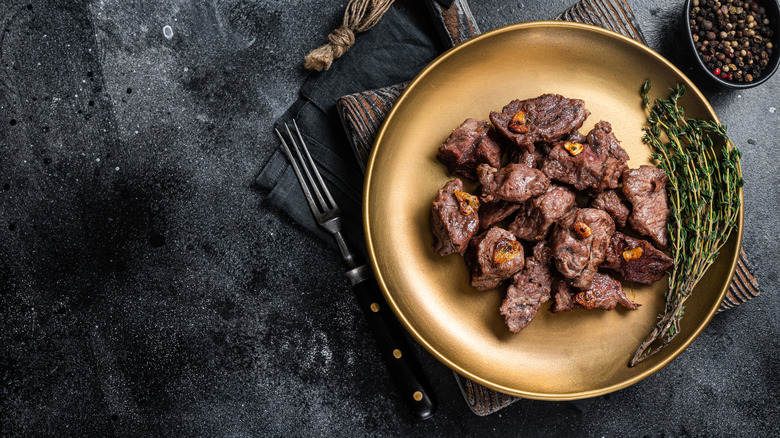The Difference Between Steak Tips On The East And West Coasts
America's East vs. West Coast rivalry encompasses not only sports teams and city preferences, but also culinary offerings. From beers and oysters to sandwiches and even longer butter sticks on the East Coast, a broad array of foodstuffs fall into the regional delineation. Another item to add to the list? Steak tips.
Depending on where you ask, the cut of beef refers to distinct types of meat. In New England, they're small, tender morsels of meat typically cut from the sirloin and designed for marinating and then delicious sizzling. Especially popular around the Boston area, they're a meat type found around casual eateries, at cheerful cookouts, and for sale at the local butcher's shop. Meanwhile, head to the West Coast — especially Central California — and steak tips refers to tri-tip. This cut is also usually butchered from the sirloin, but is presented in a whole triangular shape. As opposed to East Coast steak tips, tri-tip is deconstructed into steaks (or even kept whole) and traditionally prepared over a grill before being served in a sandwich. So, although the two cuts hail from the same beef primal, you need to note your own location to purchase from a butcher.
In New England, steak tips refer to small beef morsels
New England's beloved steak tips dependably source from one specific cut: The sirloin flap. Also called the bavette or simply the flap, the best way to cook a flap steak is via high-heat grilling or searing. Especially after some marination time, the inexpensive yet flavorful cut transforms into a tender, mouthwatering result. This part of the sirloin is also commonly employed for fajitas — which are kept whole on the grill — but butchers instead cube the beef for steak tips, yielding pieces of meat a few inches across. Although now ingrained in local culture, steak tips are a relative newcomer to New England.
The dish emerged during the 1970s, when meat sellers sought to increase sales of the then-underutilized sirloin. Influenced by Greek immigrants as well as the French en brochette technique, restaurateurs served the beef in a kebab-like preparation but sans skewer. Simultaneously, the employed marinade soaked up more American influences, relying on a pre-bottled sauce, such as Italian dressing, or a savory Worcestershire-based mix akin to barbecue sauce. By the 1980s, steak tips could be purchased pre-marinated — quite a contrast to the rub-only approach of tri-tip. To finish, the steak bites go on a grill or hot cast iron pan, achieving mouthwatering caramelization while retaining a pink, traditionally medium-rare interior. Presented alongside are classic sides, such as mashed potatoes, salad, or even a bread roll. It's a straightforward but mouthwatering New England classic, best enjoyed in a casual setting such as a family-owned restaurant, bar, or at a weekend get-together.
Central California's tri-tip is a large sirloin cut prepared on the grill
The West Coast's steak tip rendition also intertwines a specific piece of meat with a particular preparation. Here, it's all about the bigger sized tri-tip, prepared in a specific barbecue style called Santa Maria. The large, several-pound cut gets covered in a simple rub, dependably of salt and pepper and optionally embellished with additions such as dried herbs, onion powder, and garlic powder. Then, the steak's prepared on a wood-fired grill — traditionally fueled with red oak — using a combination of direct and indirect heat. As opposed to other barbecue methods, it's a quick-cooking style that's ready in under an hour.
Also called Santa Maria steak in reference to its Californian town origin, the tri-tip is one of the most flavorful budget steak cuts. The beef comes from the bottom of the sirloin — just like the sirloin flap — but this part of the muscle is sliced off at the tip, yielding the triangle-shaped cut. Fatty and flavorful, California's predisposition towards the cut has limited its popularity nationwide, although it has occasionally been spotted at Costco. Just like its regional counterpart, the best place to sample tri-tip is in the original San Luis Obispo area. Available at noted barbecue restaurants, social barbecue outings, as well as famed local farmers markets, tri-tip is traditionally consumed as a sandwich accompanied by onions and cheese on a nice roll. It's a specifically Californian creation that understandably intrigues.


